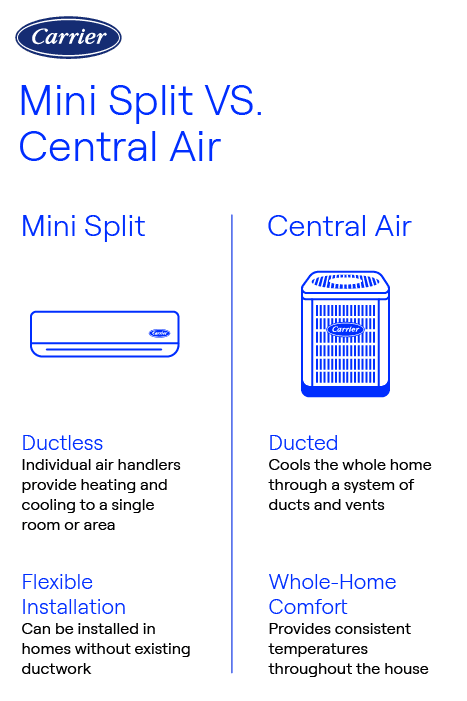Comparing Ductless Mini Split vs Central Air
Your home is your comfort zone. And to keep it that way during the heat of summer, most of today’s homes include some type of air conditioning system. With all of the options available, choosing a home comfort system can be a weighty decision. And if you are figuring out “ what is a split system air conditioner ?” or trying to make the mini split vs central air comparison, you are not alone. It’s a tough choice because central air conditioner and ductless mini split systems each have advantages and disadvantages.
While both types of systems operate on the same principals for cooling the air inside, they differ quite a bit in terms of installation, setup and delivery of cooled air. For air conditioning an entire home, ducted central air conditioners have been the gold standard. Ductless mini split systems can be used for whole-home cooling, but they are often considered a better choice for a converted a space, room addition, or adding air conditioning to an older home that does not have ductwork for forced air cooling. Learn more about HVAC options for older houses .
Carrier is known for its leadership in traditional forced air central air conditioning, but when you make your central air vs ductless comparison, be sure to check out our complete family of ductless AC and mini split systems.

Ductless Mini Splits
Exactly what is a ductless air conditioner? Similar to standard, ducted central air conditioning systems, ductless mini splits have an outdoor unit and an indoor unit. Refrigerant circulates through the system, absorbing heat and humidity from inside air. The refrigerant continues through copper tubing into the outdoor unit where the heat is released.
Here’s where the systems differ: central air systems include one indoor unit for the entire home; mini split systems require an indoor unit in every separate room that needs conditioned air. These indoor units are available as wall mounted, under ceiling, floor mounted and in ceiling. Each has a small fan inside that pushes the cooled air directly out into the living space – it truly is an air conditioner without ducts.
For comfort all year long, a ductless mini split heat pump operates on the same principal, but can reverse the process to provide both heating and cooling. Carrier also offers a complete family of mini split heat pumps for your year-round comfort needs.

Advantages of a Ductless Mini Split
Ductless mini split systems offer a number of advantages over traditional ducted systems in certain situations. They are a natural fit for room additions or when converting an unused space into a living area. They are perfect for an older home without ductwork. And, they are great for providing separate, zoned comfort control for individual rooms. Ductless mini split systems provide excellent energy efficiency as well. Here’s a closer look:
- Energy efficiency: Ductless mini split systems offer cooling efficiencies that are significantly greater than ducted cooling systems.
- Minimally invasive installation: Because it is an air conditioner without ducts, ductless mini split installation does not require major construction work. Only a small hole is needed to run refrigerant piping and wiring between the indoor and outdoor units.
- Savings on energy bills: In addition to providing high efficiency operation, a ductless mini split air conditioner can help save money by only being used when the space is occupied.
- Installation flexibility: Long refrigerant line capability, compact indoor and outdoor units, and no ductwork needed allows for installation how and where you want it, even when space is limited. Learn more about the best mini split placement within a home.
- Targeted comfort: Ductless mini split systems can heat or cool specific rooms in your home as needed, with different temperature settings for each room. They can even be used to supplement your central AC system to provide comfort in rooms that struggle with temperature control. Both single zone and multi zone mini split systems are available based on your needs. Multi zone system types include 3 zone mini splits and 4 zone mini splits.
Disadvantages of a Ductless Mini Split
Keep in mind that ductless mini split systems are not necessarily the perfect solution for all homes. For example, central air conditioning is overall less visible inside the home because there is only one indoor unit that is typically installed in a basement, utility closet or garage. Here’s more:
- Initial upfront cost: Installing a ductless mini split system to cool your entire home can be more expensive compared to a central AC system with existing ductwork.
- Visibility of the indoor units: Mini split indoor units are available as wall mounted, ceiling mounted, floor mounted or in-ceiling installation, and most of these options are easily seen in the room.
- Indoor air quality: Ductless mini split systems are less effective at air filtering than a central air conditioner. Central AC systems circulate air from the entire home through a filter to provide better control of your indoor air quality.

Are Mini Splits Worth the Cost?
If you have asked yourself, “are mini splits worth the cost?” you are not alone. But if you can afford the initial investment of the system and installation, ductless heat and cooling systems are absolutely worth the expense. They are a great long-term investment for your home that can save you money over time on energy bills, due to their efficiency and the ability to heat/cool only the area you are using.
For more information on ductless air conditioner cost, follow the link to our page dedicated to this topic.
Central Air and Heat Units
A ducted HVAC system such as central air will include and outdoor unit and one indoor unit that is typically located in a basement, garage or utility closet. The indoor unit for central air systems includes a blower fan that is powerful enough to distribute cooled air throughout the home through a series of ducts within the walls, floor or ceilings. Older homes that predate central air were not built with duct systems, which explains why many of them do not have central air.
As is the case with mini splits, a central air system works by circulating refrigerant between the indoor unit and an exterior condensing unit. A chemical refrigerant circulates through the system, absorbing heat and humidity from indoor air and releasing it outside.
Advantages of Central Air
Most modern homes are built with ducted forced air HVAC systems for cool air inside. That provides a built-in advantage for central air vs ductless. Here are some additional reasons why these systems are so popular:
- Less intrusive installation: If your home already has ductwork, you will not need to have a professional install ductwork to install a central AC system -- saving time, money and inconvenience. And, you will only need one indoor unit for the entire home versus one in each room for a ductless system.
- Convenience: Having central air allows you to cool your entire home and control the temperature from a single thermostat.
- Indoor air quality: Central air is more effective at filtering harmful particles out of the air than a ductless system. All or most of the air in your home circulates through a centrally located air handler and air filter.
- Lower systems cost: Installing a central AC system can range between $3,000- $15,000, or more to cool an entire home. To cool an entire home with ductless mini splits will require installing multiple indoor units and potentially higher cost.
Disadvantages of Central Air
Central air also comes with some disadvantages:- Cost of ductwork installation: If you are adding ducted comfort with a room addition or conversion, or if you have an older home with no existing ducts, you’ll need to add the expense of ductwork installation to your budget.
- Energy efficiency: While higher efficiency central AC systems achieve up to 26 SEER, you can find more efficient ductless systems that achieve up to 35 SEER2.
Installing Central Air in a House Without Ducts
If you are installing central air in a house without ducts, your costs can vary quite a bit. According to Fixr.com, installing new ductwork in an existing home can add up to $18,000* on top of the purchase price and installation expense for the AC system. Of course, the linear footage of ductwork, the number of vents and returns, and insulation all affect the actual cost. When you factor in the cost of the ductwork, the mini split vs central air debate might lean more towards a mini split system.

Choosing A Mini Split vs Central Air
If you are considering the advantages and disadvantages of mini split systems vs central air, the best way to get the most accurate information for your home’s unique needs would be to find a Carrier expert in your area.
* https://www.fixr.com/costs/ductwork
Frequently Asked Questions About Mini Split Vs Central Air
Learn More About Mini Split vs Central Air
- How big of a mini split do I need?
- Can you install a ductless air conditioner for garage
- Learn about mini split repairs
- How long do mini splits last?
- Learn about mini split maintenance
- Learn about the different ductless heating and cooling system types

